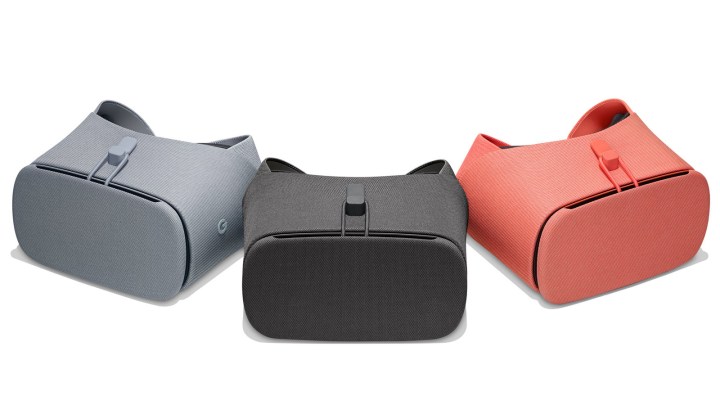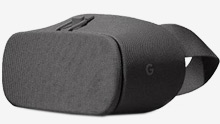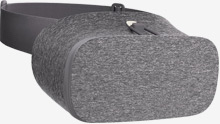
The Daydream View range is Google’s effort to offer an entry-level virtual reality headset that goes beyond something ultra-low-budget like Google Cardboard, without costing the world. It achieved that through leveraging the user’s smartphone for the expensive, display and processing technology of a VR headset, while providing an attractive and comfortable head mounting system.
With the Daydream View 2, it’s looking to make the experience that bit better.
Specifications
| Daydream View 2 (2017) | Daydream View (2016) | |
| Dimensions | 6.6 × 4.6 × 3.9 inches | 6.6 × 4.2 × 3.8 inches |
| Weight | 260 grams | 220 grams |
| Optical Lens | New custom fresnel design | Custom fresnel lenses |
| Display | Device dependent | Device dependent |
| Field of view | 100-degrees | 90-degrees |
| Smartphone support | Google Pixel 2, Pixel 2 XL, Samsung Galaxy S8, S8+, Note 8, Asus Xenfone AR, LG V30, Motorola Moto Z, Moto Z Force, Moto Z2 Force, ZTE Axon 7, Huawei Mate 9 Pro, Porsche Design Mate 9 | Google Pixel 2, Pixel 2 XL, Samsung Galaxy S8, S8+, Note 8, Asus Xenfone AR, LG V30, Motorola Moto Z, Moto Z Force, Moto Z2 Force, ZTE Axon 7, Huawei Mate 9 Pro, Porsche Design Mate 9 |
| Sensors | Accelerator, gyrometer, proximity | Accelerator, gyrometer, proximity |
| Controller | Wireless remote controller | Wireless remote controller |
| Color options | Charcoal, fog and coral | Slate, snow, and crimson |
| Price | $100 | $80 |
| Availability | Launching October 19 | On sale |
Looking at the specifications, you’d be forgiven for thinking that not much has changed between the two versions of the Daydream View. The only real changes by the numbers are a slight increase in the dimensions and weight of the 2017 model, a mildly expanded field of view, and a price bump of $20. The controllers are the same, the sensor suite is the same and the color options aren’t even that different.
However, the few number differences that exist between the two headset generations don’t tell the whole story.
The VR view
With the announcement of the Daydream 2, Google also expanded the number of compatible smartphones with the platform. Although those phones should also be compatible with the original Daydream View headset, bringing handsets like the Google Pixel 2 to the table means the potential for an improved visual experience when in Daydream VR.
On top of that, Google has taken steps to improve the look of the virtual world no matter what handset you’re using. The new lenses in the Daydream View 2 are a custom fresnel design which Google claims it manufactured after running masses of simulations to figure out the ideal lens design (as per RoadtoVR).
Those lenses enable an additional 10 degrees field of view, which may not seem like a lot, but should make a big difference to the immersive feeling of Daydream VR. It represents an 11 percent increase in the field of view, and is said to be a noticeable difference when in use. Just as important though, is that this makes the Daydream field of view comparable to that of the Samsung Gear VR.
Another addition that won’t make the specifications list, is a new heatsink built into the Daydream View 2. When in use, it helps cool the smartphone, and allows for longer sessions of high-performance virtual reality before having to stop to let the
Comfort
Arguably the biggest changes made to the second-generation Daydream headset are in the realm of comfort. Although we found the original Daydream View to be a comfortable portable VR headset, not everyone was so fortunate. Some found that it pressed too heavily on their cheekbones, and face shape seemed to play a particular role in how comfortable a user found it.
With the new Daydream View 2, Google has overhauled its foam padding, making it larger and softer. It has also reportedly tested it on a larger number and wider variety of users. That means whether you’re male or female, and whatever your facial structure, the new Daydream View 2 should be more comfortable to wear for longer periods.

To further improve comfort and weight distribution, the new Daydream View comes with an over-the-top headstrap. That’s probably a good idea, as there is a slight increase in weight of the Daydream 2 over its predecessor. In case you don’t like the new strap, though, Google has made it easy to remove.
Whether you use it or not though, that strap now has a little pocket in the back for the remote controller too, storing it there rather than in the front of the headset.
Smartphone Support
Although the new Daydream View 2 supports Google’s new Pixel 2 and Pixel 2 XL smartphones, those have simply become part of the “Daydream Ready” smartphone list. Google doesn’t differentiate between headsets in that respect, so whichever version of the View you have, the compatible smartphones should be the same.
There are now 15 mobile handsets that are compatible with Daydream View headsets, with Google listing them all on its compatibility page. That’s more than it ever expected to support by this time. They include: Google Pixel, Pixel XL, Pixel 2, Pixel 2 XL, Samsung Galaxy S8, S8+, Note 8, Asus Xenfone AR, LG V30, Motorola Moto Z, Moto Z Force, Moto Z2 Force, ZTE Axon 7, Huawei Mate 9 Pro, and Porsche Design Mate 9.
Software
Much like the smartphone compatibility, there is no difference between the Daydream View 2 and the original version when it comes to available applications. They include the likes of Netflix VR, Jaunt VR, Youtube VR, Hulu, HBO Go VR, Sky VR, and sporting apps like the NBA VR, and NFL VR experiences.
There are also standalone games and experiences like DominoVR, Tiny War, Toy Clash, Chicken Slayer, and Danger Goat, among others, with newly compatible apps becoming available all the time.
Because the underlying hardware of the Daydream platform is dependent on the smartphone that’s running it, it seems unlikely that there will be any sort of generational split with the software.
Price and availability
The original Daydream View has an advantage when it comes to pricing. At $80, it costs $20 less than its younger sibling. It’s also available right now, whereas the Daydream View 2 isn’t set for release until October 19. If you haven’t picked up a View already, and like the look of the new version, the wait isn’t exactly a long one.
Conclusion
The Daydream View 2 should be a superior Daydream virtual reality headset, though it’s very much an evolution of the original, rather than a revolution. This is to be expected considering it’s been less than a year since the release of the first generation DayDream View.
This means that the original View remains a viable entry-point for mobile virtual reality, especially if you’re planning to buy, or already own, one of the expanded list of compatible smartphones. However, the View 2 is undoubtedly the superior headset, so unless you really need to save that $20, it’s going to be the better option.
Whether it’s worth the upgrade is another matter entirely. There aren’t significant enough changes to truly recommend spending another $100 just for improvements in comfort, especially when the original View benefits from the same growing software library and smartphone compatibility as its successor.
Editors' Recommendations
- Google Drive vs. Dropbox: which is best in 2024?
- How to use Google Drive
- Google Stadia vs. xCloud
- Google Pixel Slate vs. Google Pixelbook






